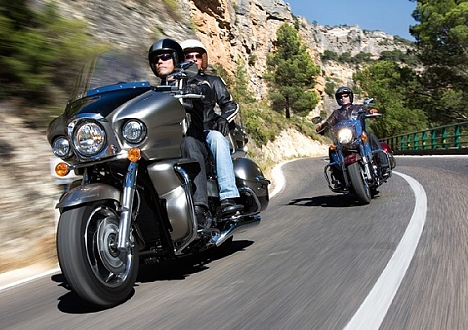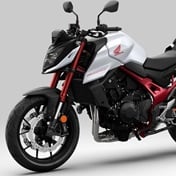
This is the future of Kawasaki’s cruisers. Slipping in next to the VN1700 Classic (and two other 1700 cruisers that aren’t coming to our shores), the new Voyager claims to be Japan’s first full-dress V-Twin cruiser, powered by a brand new 1,7 litre V-twin engine which is based on the two-litre VN2000 cruiser’s powersource.
The new 1.7l liquid-cooled engine (the same one that powers the VN1700 Classic) uses a single overhead camshaft to operate the valves, rather than the push rods of the bigger two-litre engine. Its long stroke construction (bore and stroke of 102 X 104mm) and eight-valve architecture were calculated to deliver massive torque rather than chunky kilowatts, so the result is a 15% increase in Nm over the outgoing 1.6l mill.
A semi-dry sump, like that of the VN2000, meant that the crankshaft could be mounted lower in the crankcases so the long stroke did not incur a penalty in excessive height. Both pistons are mounted on a single crank pin, and dual counter-balance shafts help soak up vibration. Not all vibration, mind you – just the annoying kind. A big twin should always be left with some of the character of two large pistons rushing up and down its bores.
Kawasaki has used the Voyager tag before, but never for a V-Twin. The first version was born in 1983, when the company created a six-cylinder version as the first full-dress tourer. Then in 1986 they switched to a four-cylinder 1200cc engine for the second incarnation. The bikes developed a cult following, particularly in the USA, and production continued until 2003 with very few changes.
The Kawasaki VN1700 is sold in two guises in South Africa. There’s the VN1700E Classic, a buck-naked slim-’n’-trim street cruiser, and the full-dress VN1700B Voyager cruiser with bucketloads of computing power. In the states another two models compliment the lineup: an LT version of the Classic with leather saddlebags and taller windscreen and the Nomad, essentially a touring version of the classic. Together the four models comprise the Vulcan cruiser range.
Both models available in SA use the same basic engine with minor tuning changes. The naked bike’s state of tune translates into maximum power and torque at 4500r/min and 2250r/min respectively rather than the 5000r/min and 2750r/min peaks of the dresser.
Expect just about every imaginable luxury on the Voyager. The passenger gets a sculpted seat, with a backrest and arm support, as well as a set of comfort floorboards. A 50l rear storage compartment take care of two full-face crash helmets, and dual 38l hard lockable panniers, as well as lockable glove compartments in the fairing, serves as stowage for smaller items.
The front cowling and windscreen are mounted to the frame rather than the front forks which Kawasaki says has a positive effect on its handling and ease of turning at low speeds. Leg shields with adjustable ventilation will keep you cool in the summer and toasty in the winter, and the bike is shorter and lighter than the previous two litre and 1.6l models.
The VN1700 model range differs sharply from the outgoing 1,6l models in that final drive is now by a drive belt, rather than the shaft drive of the 1600cc models. A move that won’t sit well with all riders, but a belt drive does mean less maintenance and the carbon fibre version Kawasaki has opted for is 40% stronger than the standard Kevlar belt.
To keep the Voyager as lightweight as such a cruiser can be, Kawasaki has kept the number of forged components at a minimum. This resulted in a frame that is actually lighter than the 1600’s, but boasts greater torsional rigidity. A sizeable 20l fuel tank should offer substantial range between forecourt stops.
The Kawasaki VN1700 Voyager also gets its fair share of technology. There is K-ACT (Kawasaki Advanced Coactive Braking) ABS which provides effective stopping under challenging conditions, while Kawasaki’s first electronic throttle valve system offers smooth engine response and easy starting.
Kawasaki reckons the braking system is one of the biggest selling points as it monitors break forces through the system’s computer and “juggles them between the front and rear wheels to provide maximum braking effect, irrespective of what lever or pedal the rider is manipulating.”
They further claim this “juggling” between front and rear to be seamless while “the rider remains totally unaware of the guardian angel electronically monitoring his rate of retardation.” Sounds like a big sell for a small system, so obviously we can’t wait to put it to the test on some rain-drenched winter roads.
The K-ACT system’s coactive function is disabled at speeds below 20 km/h to allow the rider more control in tight turns, while the ABS system disengages at speeds below 6km/h. An on-board computer displays the remaining fuel range, average fuel consumption and the current gear (the Voyager gets a new slick-shifting six-speed gearbox with an overdrive gear). Instead of dual pipes sweeping along the right hand side like on the VN1700 Classic, the Voyager gets twin silencers, one on each side of the machine.
With this new addition to the powerful Kawasaki V-twin cruiser range, buyers have the option between a trim and tidy naked boulevard cruiser, or a full-house full-dress trans-continental tourer.
The loping big V-twin engines are said to deliver effortless torque at low revs for easy riding, while the new frames ensure the bikes are easy to handle about town and remains stable on the highway. We just love the retro-styled bodywork and lashings of chrome.
The Kawasaki VN1700 Voyager retails for R220 995 and the VN1700 Classic R155 995 (both come with two year / unlimited distance warranties). This is significantly cheaper than the Harley Davidson counterparts (the Electra Glide will set you back significantly more at R317 000 and the Road King Classic R276 000).
Would you pick one of Kawasaki’s cruisers over a Harley?
Technical specifications: Kawasaki VN1700 Voyager
Bore x stroke: 102 x 104 mm
Compression ratio: 9.5:1
Valve/Induction system: SOHC, 8 valves
Maximum power: 61 kW at 5 000 r/min
Maximum torque: 146 Nm at 2 750 r/min
The new 1.7l liquid-cooled engine (the same one that powers the VN1700 Classic) uses a single overhead camshaft to operate the valves, rather than the push rods of the bigger two-litre engine. Its long stroke construction (bore and stroke of 102 X 104mm) and eight-valve architecture were calculated to deliver massive torque rather than chunky kilowatts, so the result is a 15% increase in Nm over the outgoing 1.6l mill.
A semi-dry sump, like that of the VN2000, meant that the crankshaft could be mounted lower in the crankcases so the long stroke did not incur a penalty in excessive height. Both pistons are mounted on a single crank pin, and dual counter-balance shafts help soak up vibration. Not all vibration, mind you – just the annoying kind. A big twin should always be left with some of the character of two large pistons rushing up and down its bores.
Kawasaki has used the Voyager tag before, but never for a V-Twin. The first version was born in 1983, when the company created a six-cylinder version as the first full-dress tourer. Then in 1986 they switched to a four-cylinder 1200cc engine for the second incarnation. The bikes developed a cult following, particularly in the USA, and production continued until 2003 with very few changes.
The Kawasaki VN1700 is sold in two guises in South Africa. There’s the VN1700E Classic, a buck-naked slim-’n’-trim street cruiser, and the full-dress VN1700B Voyager cruiser with bucketloads of computing power. In the states another two models compliment the lineup: an LT version of the Classic with leather saddlebags and taller windscreen and the Nomad, essentially a touring version of the classic. Together the four models comprise the Vulcan cruiser range.
Both models available in SA use the same basic engine with minor tuning changes. The naked bike’s state of tune translates into maximum power and torque at 4500r/min and 2250r/min respectively rather than the 5000r/min and 2750r/min peaks of the dresser.
Expect just about every imaginable luxury on the Voyager. The passenger gets a sculpted seat, with a backrest and arm support, as well as a set of comfort floorboards. A 50l rear storage compartment take care of two full-face crash helmets, and dual 38l hard lockable panniers, as well as lockable glove compartments in the fairing, serves as stowage for smaller items.
The front cowling and windscreen are mounted to the frame rather than the front forks which Kawasaki says has a positive effect on its handling and ease of turning at low speeds. Leg shields with adjustable ventilation will keep you cool in the summer and toasty in the winter, and the bike is shorter and lighter than the previous two litre and 1.6l models.
The VN1700 model range differs sharply from the outgoing 1,6l models in that final drive is now by a drive belt, rather than the shaft drive of the 1600cc models. A move that won’t sit well with all riders, but a belt drive does mean less maintenance and the carbon fibre version Kawasaki has opted for is 40% stronger than the standard Kevlar belt.
To keep the Voyager as lightweight as such a cruiser can be, Kawasaki has kept the number of forged components at a minimum. This resulted in a frame that is actually lighter than the 1600’s, but boasts greater torsional rigidity. A sizeable 20l fuel tank should offer substantial range between forecourt stops.
The Kawasaki VN1700 Voyager also gets its fair share of technology. There is K-ACT (Kawasaki Advanced Coactive Braking) ABS which provides effective stopping under challenging conditions, while Kawasaki’s first electronic throttle valve system offers smooth engine response and easy starting.
Kawasaki reckons the braking system is one of the biggest selling points as it monitors break forces through the system’s computer and “juggles them between the front and rear wheels to provide maximum braking effect, irrespective of what lever or pedal the rider is manipulating.”
They further claim this “juggling” between front and rear to be seamless while “the rider remains totally unaware of the guardian angel electronically monitoring his rate of retardation.” Sounds like a big sell for a small system, so obviously we can’t wait to put it to the test on some rain-drenched winter roads.
The K-ACT system’s coactive function is disabled at speeds below 20 km/h to allow the rider more control in tight turns, while the ABS system disengages at speeds below 6km/h. An on-board computer displays the remaining fuel range, average fuel consumption and the current gear (the Voyager gets a new slick-shifting six-speed gearbox with an overdrive gear). Instead of dual pipes sweeping along the right hand side like on the VN1700 Classic, the Voyager gets twin silencers, one on each side of the machine.
With this new addition to the powerful Kawasaki V-twin cruiser range, buyers have the option between a trim and tidy naked boulevard cruiser, or a full-house full-dress trans-continental tourer.
The loping big V-twin engines are said to deliver effortless torque at low revs for easy riding, while the new frames ensure the bikes are easy to handle about town and remains stable on the highway. We just love the retro-styled bodywork and lashings of chrome.
The Kawasaki VN1700 Voyager retails for R220 995 and the VN1700 Classic R155 995 (both come with two year / unlimited distance warranties). This is significantly cheaper than the Harley Davidson counterparts (the Electra Glide will set you back significantly more at R317 000 and the Road King Classic R276 000).
Would you pick one of Kawasaki’s cruisers over a Harley?
Technical specifications: Kawasaki VN1700 Voyager
Bore x stroke: 102 x 104 mm
Compression ratio: 9.5:1
Valve/Induction system: SOHC, 8 valves
Maximum power: 61 kW at 5 000 r/min
Maximum torque: 146 Nm at 2 750 r/min




 Publications
Publications
 Partners
Partners

















